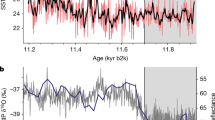Abstract
THE Earth's orbit about the Sun is influenced by gravitational interactions with the Moon and other planets. The resulting orbital perturbations give rise to cyclical variations in orbital eccentricity, obliquity and precession with periods of 100, 41, 19 and 23 kyr, respectively1. These variations are climatically important because they affect the seasonal and latitudinal distribution of solar radiation. Magnetic-susceptibility measurements in deep-sea sediment cores can be used as a sensitive indicator of temporal variations in the concentration of terrigenous material supplied to the sea bed. Here we use this approach to study the evolution of cycles of terrigenous sedimentation at Ocean Drilling Program sites in the Arabian Sea and the eastern tropical Atlantic. We show, from spectral analyses of the two susceptibility time series spanning the past 3.2–3.5 Myr, that the records are driven strongly by orbital forcing. Before 2.4 Myr before present (BP), both records are strongly influenced by the 23- and 19-kyr periodicities; but after 2.4 Myr, they are both significantly influenced by the 41-kyr periodicity. This shift coincides with the beginning of major Northern Hemisphere glaciation, which indicates, for the Indian Ocean site, that the supply of terrigenous sediment (carried by monsoonal winds) has responded to the rapid increase in ice cover at this time. We cannot, however, exclude possible effects of changes in bottom-water circulation on the susceptibility record of the Atlantic site.
This is a preview of subscription content, access via your institution
Access options
Subscribe to this journal
Receive 51 print issues and online access
$199.00 per year
only $3.90 per issue
Buy this article
- Purchase on Springer Link
- Instant access to full article PDF
Prices may be subject to local taxes which are calculated during checkout
Similar content being viewed by others
References
Berger, A. L. Quat. Res. 9, 139–167 (1978).
Shackleton, N. & Opdyke, N. Geol. Soc. Am. Mem. 145, 449–464 (1976).
Imbrie, J. et al. in Milankovitch and Climate, Vol. 1, 269–305 (Reidel, Hingham, Massachusetts, 1984).
Ruddiman, W. & Mclntyre, A. Bull. geol. Soc. Am. 95, 381–396 (1984).
Pokras, E. & Mix, A. Quat. Res. 24, 137–149 (1985).
Prell, W. & Van Campo, E. Nature 323, 526–528 (1986).
Mix, A. & Fairbanks, R. Earth planet. Sci. Lett. 73, 231–243 (1985).
Barnola, J. M., Raynaud, D., Korotkevitch, Y. S. & Lorius, C. Nature 329, 408–414 (1987).
Kent, D. V. Nature 299, 538–539 (1982).
Bloemendal, J., Lamb, B. & King, J. W. Paleoceanography 3, 61–87 (1988).
Doh, S.-J., King, J. W. & Lienen, M. Paleoceanography 3, 89–112 (1988).
Pye, K. in Aeolian Dust and Dust Deposits, 76 (Academic, New York, 1987).
Ramage, C. S. J. atmos. Sci. 23, 144 (1965).
Prell, W. L. & Kutzbach, J. E. J. geophys. Res. 92, 8411–8425 (1987).
Sirocko, F. R. & Sarnthein, M. NATO Adv. Res. Workshop (Oracle, Arizona, 1987).
Clemens, S. & Prell, W. Paleoceanography (in the press).
Propero, J. M. et al. Rev. Geophys. Space Phys. 21, 1607–1629 (1983).
Ruddiman, W. F., Cameron, D. & Clement, B. M. in Init. Rep. DSDP Leg 94, 615–634 (1986).
Ruddiman, W. F. & Sarnthein, M. in Init. Rep. OOP 108 A (1988).
Prell, W. L. & Niitsuma, N. in Init Rep. ODP Leg 117 (in the press).
Bloomfield, P. Fourier Analysis of Time Series: An Introduction 258 (Wiley, New York, 1976).
Martinson, D. G., Menke, W. & Stoffa, P. J. geophys. Res. 87, 4807–4818 (1982).
deMenocal, P., Bloemendal, J., King, J. W., Debrabant, P. & Chamley, H. in Init. Rep. ODP Leg 117 (in the press).
Rea, D. K. & Janecek, T. R. in Init. Rep. DSDP Leg 62, 653–659 (1981).
Shackleton, N. J. et al. Nature 307, 620–623 (1984).
Ruddiman, W. F., Raymo, M. E. & Mclntyre, A. Earth planet Sci. Lett. 80, 117–129 (1986).
Rind, D. J. geophys. Res. 92, 4241–4281 (1987).
Sarnthein, M. Nature 272, 43 (1978).
Street, F. A. & Grove, A. T. Quat Res. 12, 83 (1979).
Van Campo, E., Duplessy, J.-C. & Rossignol-Strick, M. Nature 296, 56–59 (1982).
Author information
Authors and Affiliations
Rights and permissions
About this article
Cite this article
Bloemendal, J., deMenocal, P. Evidence for a change in the periodicity of tropical climate cycles at 2.4 Myr from whole-core magnetic susceptibility measurements. Nature 342, 897–900 (1989). https://doi.org/10.1038/342897a0
Received:
Accepted:
Issue Date:
DOI: https://doi.org/10.1038/342897a0
This article is cited by
-
Localized environmental heterogeneity drives the population differentiation of two endangered and endemic Opisthopappus Shih species
BMC Ecology and Evolution (2021)
-
Relationship between soil magnetic susceptibility enhancement and precipitation in Cretaceous paleosols
Studia Geophysica et Geodaetica (2021)
-
GEOMAGIA50.v3: 2. A new paleomagnetic database for lake and marine sediments
Earth, Planets and Space (2015)
-
Characterizing magnetic mineral assemblages of surface sediments from major Asian dust sources and implications for the Chinese loess magnetism
Earth, Planets and Space (2015)
-
Effect of precession on the Asian summer monsoon evolution: A systematic review
Chinese Science Bulletin (2009)
Comments
By submitting a comment you agree to abide by our Terms and Community Guidelines. If you find something abusive or that does not comply with our terms or guidelines please flag it as inappropriate.



